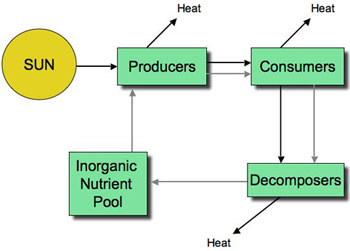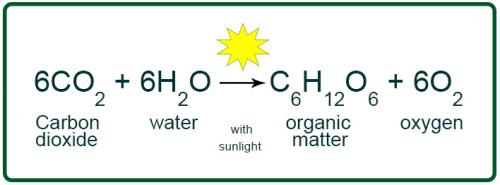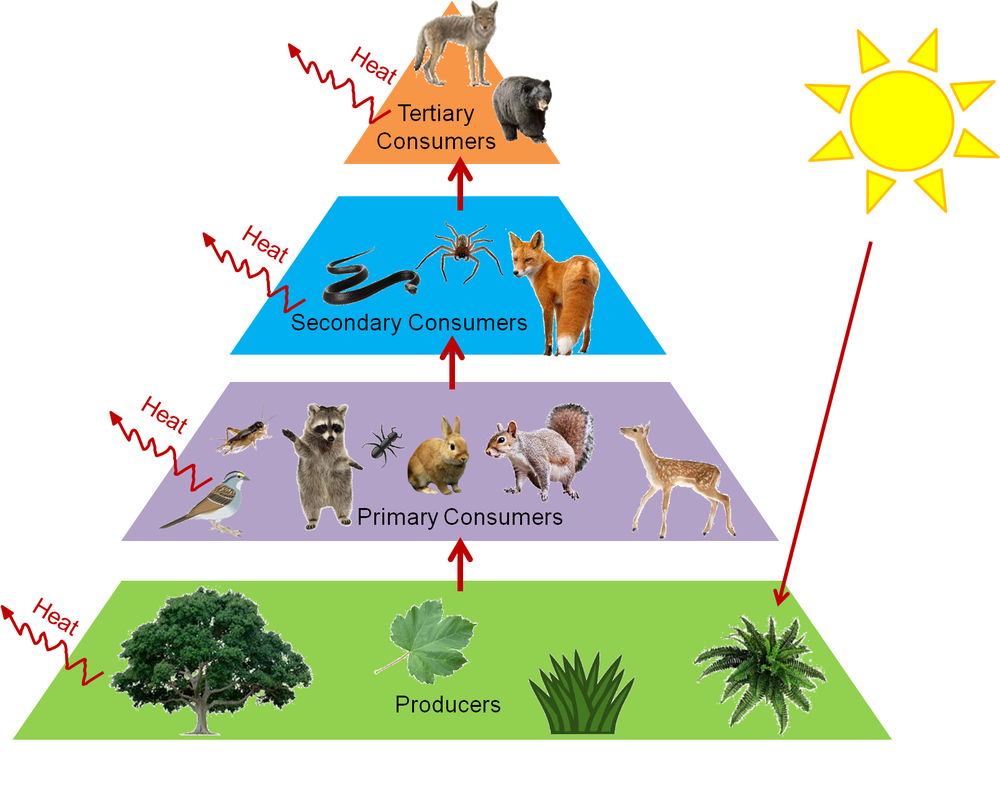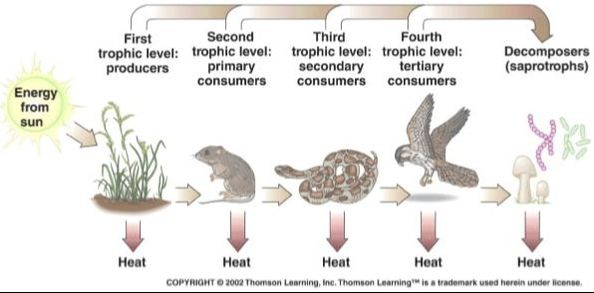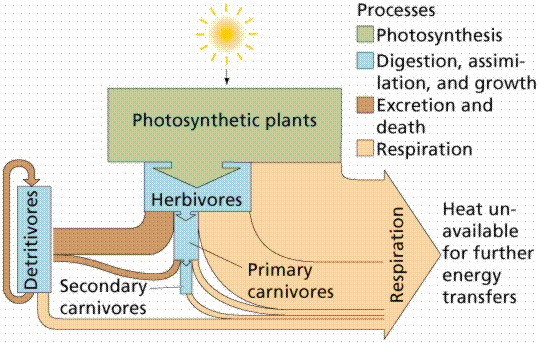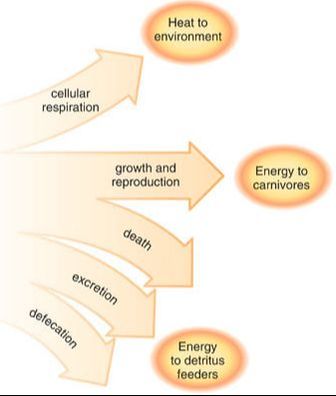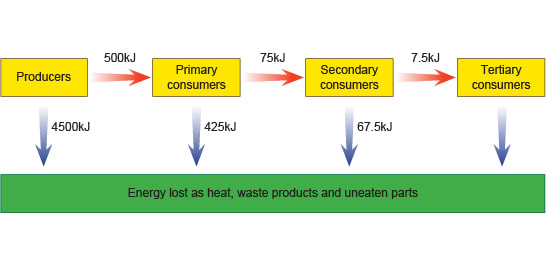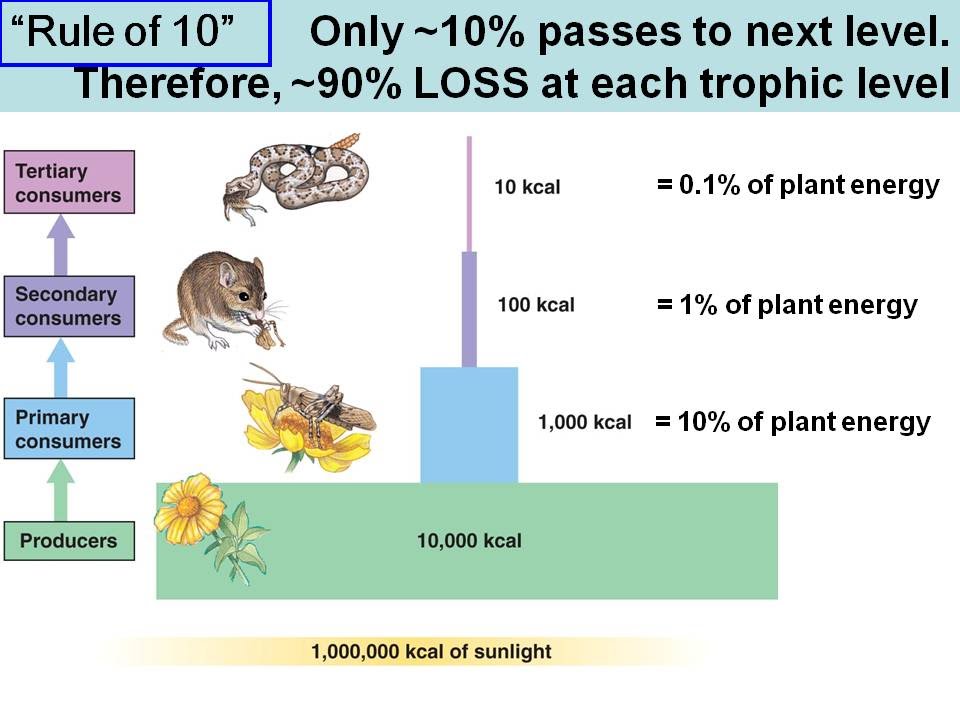4.2 Energy flow
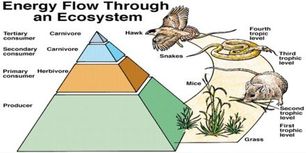
In the unit of Energy Flow, we will look at how organism need food to survive but eventually it too is eaten. In any ecosystem there is a hierarchy of feeding relationships that influences how nutrients and energy pass through it. We will also look at the sequence of organisms that provide food for one another is know as a food chain.
This unit will last 3 school days
This unit will last 3 school days
Essential idea:
- Ecosystems require a continuous supply of energy to fuel life processes and to replace energy lost as heat.
Nature of science:
- Use theories to explain natural phenomena—the concept of energy flow explains the limited length of food chains. (2.2)
- Explain why there is a limited number of organisms in a food chain.
- Explain why there is a limited number of organisms in a food chain.
Understanding
4.2.U1 Most ecosystems rely on a supply of energy from sunlight.
- State how energy in carbon compounds enters most biological communities.
- List three groups of autotrophs.
ll green plants, and some bacteria, are photoautotrophic – they use sunlight as a source of energy. This makes light the initial source of energy for almost all communities
In a few ecosystems the producers are chemoautotrophic bacteria, which use energy derived from chemical processes
In a few ecosystems the producers are chemoautotrophic bacteria, which use energy derived from chemical processes
- Most ecosystems rely on a supply of energy from sunlight
- Living organisms can harvest this energy through the process of photosynthesis
- Autotrophs of plants, cyanobacteria, eukaryotic algae also carry out photosynthesis
4.2.U2 Light energy is converted to chemical energy in carbon compounds by photosynthesis.
- Outline how light energy is converted to chemical energy.
Producers absorb sunlight using chlorophyll and other photosynthetic pigments.
- Converts light energy to chemical energy used to make carbo hydrates, lipids, and other carbon compounds
- Produces can release energy from their carbon compounds by cell respiration and the use it for cell activities
- Energy released this way is eventually lost to environment as waste heat
- Light energy is converted to chemical energy in carbon compounds by photosynthesis
- Light energy is converted to chemical energy in order to make lipids, carbohydrates and other carbon compounds found in producers
- In addition, the producers absorb the sunlight using photosynthetic pigments and chlorophyll
4.2.U3 Chemical energy in carbon compounds flows through food chains by means of feeding.
(Students should be clear that biomass in terrestrial ecosystems diminishes with energy along food chains due to loss of carbon dioxide, water and other waste products, such as urea. (Pyramids of number and biomass are not required.)
(Students should be clear that biomass in terrestrial ecosystems diminishes with energy along food chains due to loss of carbon dioxide, water and other waste products, such as urea. (Pyramids of number and biomass are not required.)
- Define food chain and food web.
- State the meaning of the arrow in a food web or chain.
- Draw a food chain, labeling the producer, primary consumer, secondary consumer and tertiary consumer.
Energy enters most ecosystems as sunlight, where it is converted into chemical energy by producers (via photosynthesis). This chemical energy is stored in carbon compounds (organic molecules) and is transferred to heterotrophs via feeding
- Food chain: a sequence of organisms, each of which feeds on the previous one.
- Carbon compounds store chemical energy in C-C bond
- Heterotrophs fed on living organisms by ingestion
- Saprotrophs feed on dead organisms by external digestion
- Usually 2-5 organisms in a food chain
- Producers are always first (they do not obtain food from other organisms)
- Subsequent organisms are consumers
- Primary consumers feed on producers; secondary consumers feed on primary consumers; tertiary consumers feed on secondary consumers – so on.
4.2.U4 Energy released from carbon compounds by respiration is used in living organisms and converted to heat.
- List three reasons why living organisms need energy for cell activities.
- State the function of ATP.
- Outline how ATP is formed, referencing exothermic and endothermic reactions.
- Outline the reason why respiration releases heat.
Energy stored in organic molecules (e.g. sugars and lipids) can be released by cell respiration to produce ATP
- Living organisms need energy for cell activities:
- Synthesizing large molecules (DNA, RNA, proteins)
- Pumping molecules or ions across membranes by active transport
- Moving things around inside cell (chromosomes or vesicles; muscle cells – protein fibers that cause muscle contraction)
- ATP supplies energy for those activities. Every cell produces its own ATP supply
- All cells can produce ATP by cell respiration
- Carbohydrates and lipids are oxidized – exothermic. Energy released is used in endothermic reactions to make ATM
- Cell respiration transfers chemical energy from glucose and other carbon compounds to ATP
- Chemical energy in carbon compounds such as glucose is not immediately usable by the cell but chemical energy in ATP can be used directly for many different activities
- Energy transformations are never 100% efficient – not all of the energy from the oxidation of carbon compounds in cell respiration is transferred to ATP.
- Remainder is converted to heat
- Some heat is produced when ATP is used in cell activities
4.2.U5 Living organisms cannot convert heat to other forms of energy.
- Draw a flow chart to illustrate the energy conversions performed by living organisms.
Living organisms can perform various energy conversions:
- Light energy -> chemical energy (photosynthesis)
- Chemical energy -> kinetic energy (muscle contraction)
- Chemical energy -> electrical energy (nerve cells)
- Chemical energy -> heat energy (heat-generating adipose tissue)
- only a portion of energy in any level is transferred to the next, commonly being 10-20%
- of the plant biomass consumed by a typical herbivore:
- 50% is not assimilated: lost as feces (indigestible cellulose)
- 35% is assimilated but lost as heat during cellular respiration
- 15% is consumed and assimilated and incorporated into biomass
4.2.U6 Heat is lost from ecosystems.
- State the reason why heat created by living organisms is eventually lost from the ecosystem.
All of these reactions are exothermic and release thermal energy (heat) as a by-product
- Living organisms cannot turn this heat into other forms of usable energy
- This heat energy is released from the organism and is lost from the ecosystem (unlike nutrients, which are recycled)
- Hence ecosystems require a continuous influx of energy from an external source (such as the sun)
- Heat resulting from cell respiration makes living organisms warmer
- Can be useful in making cold-blooded animals more active
- Birds/mammals increase rate of heat generation if necessary to maintain constant body temperatures
- Heat passes from hotter to cooler bodies – heat produced in living organisms is all eventually lost to abiotic environment
- Heat may remain in ecosystem for a while but ultimately is lost
- All energy released by respiration for use in cell activities will ultimately be lost from an ecosystem
4.2.U7 Energy losses between trophic levels restrict the length of food chains and the biomass of higher trophic levels. (The distinction between energy flow in ecosystems and cycling of inorganic nutrients should be stressed. Students should understand that there is a continuous but variable supply of energy in the form of sunlight but that the supply of nutrients in an ecosystem is finite and limited.)
- Define biomass.
- Define trophic level.
- State the unit used for communicating the energy in each trophic level of a food chain.
- Outline three reasons why the amount of energy decreases at higher trophic levels.
- State the average amount of energy passed through each trophic level of a food chain.
A food web is the elaborate interconnected relationships within an ecosystem based on feeding and energy transfer
When energy transformations take place in living organisms the process is never 100% efficient
When energy transformations take place in living organisms the process is never 100% efficient
- Most of the energy is lost to the organism – either used in respiration, released as heat, excreted in faeces or unconsumed
- Typically energy transformations are ~10% efficient, with about 90% of available energy lost between trophic levels
- The amount of energy transferred depends on how efficiently organisms can capture and use energy (usually between 5 – 20%
- Biomass: the total mass of a group of organisms.
- Consists of the cells and tissues of those organisms, including carbohydrates / other carbon compounds they contain
- Carbon compounds have chemical energy, therefore biomass has energy
- Can measure how much energy is added per year by groups of organisms to their biomass.
- Results calculated per square meter of ecosystem (different trophic levels can be compared)
- The energy added to biomass each successive trophic level is less.
- Loss of energy between trophic levels:
- Most of energy in food is digested and absorbed by a trophic level is released by them in respiration for use in cell activities – lost as heat
- Organisms in a trophic level are not usually entirely consumed by organisms in the next trophic level.
- Predators may not eat material from the bodies of their prey such as bones or hair.
- Energy in uneaten material passes to saprotrophs or detritivores rather than passing to organisms in the next trophic level
- Not all parts of food ingested by the organisms in a trophic level are digested and absorbed. Some material is indigestible and is egested in feces. – Passed on to saprotrophs or detritivores.
- Only small proportion of energy in the biomass of organisms in one trophic level will ever become part of the biomass of organisms in the next trophic level.
- As losses occur at each stage in the food chain, there is gradually less energy available to each successive trophic level.
- Biomass (measured in grams) also diminishes along food chains due to loss of carbon dioxide and water from respiration and loss from the food chain of uneaten or undigested parts of organisms
- Biomass of higher trophic levels is usually smaller than of lower levels
Skill
4.2.S1 Quantitative representations of energy flow using pyramids of energy. (Pyramids of energy should be drawn to scale and should be stepped, not triangular. The terms producer, first consumer and second consumer and so on should be used, rather than first trophic level, second trophic level and so on.)
- Describe the shape and units of a pyramid of energy.
- Draw a pyramid of energy given data for an ecosystem.
A pyramid of energy shows the flow of energy from one trophic level to the next in a community. The units of pyramids of energy are, therefore, energy per unit area per unit time, for example, kJ m-2 yr-1. The pyramid demonstrates that energy transformations between trophic levels are never 100% efficient
Pyramids of energy will never appear inverted as some of the energy stored in one source is always lost upon transfer. Each level should be roughly one tenth of the size of the preceding level (as energy transformations are ~10% efficient)
The bottom level will always represent the producers, with subsequent levels representing consumers (primary, secondary, etc.)
Pyramids of energy will never appear inverted as some of the energy stored in one source is always lost upon transfer. Each level should be roughly one tenth of the size of the preceding level (as energy transformations are ~10% efficient)
The bottom level will always represent the producers, with subsequent levels representing consumers (primary, secondary, etc.)
Key Terms
|
ecology
ecosystem community biotic food chain herbivore heat loss kJ/m-2/y-1 |
food web
pyramid of energy biomass biome consumer carnivore energy conversion insoulation |
trophic level
pyramid energy nutrient food web omnivore energy release 2nd Law of Thermodynamics |
saprophites
photosynthesis recycle glucose primary consumer energy flow detrivores |
sunlight
producer respiration chemical energy secondary consumer nutrient flow pyramid of biomass |
Classroom Material
Food Chains and Food Webs worksheet
Food Chains, Food Webs, and Energy Pyramid worksheet
Constructing Ecological Pyramids
Ecology and Energy Flow DBQ (pdf)
Topic 4.2 Review Sheet
Food Chains and Food Webs worksheet
Food Chains, Food Webs, and Energy Pyramid worksheet
Constructing Ecological Pyramids
Ecology and Energy Flow DBQ (pdf)
Topic 4.2 Review Sheet
PowerPoint and Study Guide on Topic 4.2 by Chris Paine
Your browser does not support viewing this document. Click here to download the document.
Your browser does not support viewing this document. Click here to download the document.
Correct use of terminology is a key skill in Biology. It is essential to use key terms correctly when communicating your understanding, particularly in assessments. Use the quizlet flashcards or other tools such as learn, scatter, space race, speller and test to help you master the vocabulary.
Good video review over Topic 4.2
Useful Resources
Energy flow animation, from MHHE
Global Carbon Cycle tutorial, from Freeman
Nitrogen Cycle animations from Nodvin.net and from ClassZone.com
The Calcium Cycle, from Bill Duesing
Biogeochemical cycles, from Wikilabs
Nitrogen cycle
Energy flow animation, from MHHE
Global Carbon Cycle tutorial, from Freeman
Nitrogen Cycle animations from Nodvin.net and from ClassZone.com
The Calcium Cycle, from Bill Duesing
Biogeochemical cycles, from Wikilabs
Nitrogen cycle
In The News
Everything is Connected (2013)
Beachgoers In Spain Face Invasion Of Jellyfish (2013-08-27)
Australian Cats and Foxes May Not Deserve Their Bad Rep (2013-08-23)
What we eat makes a difference (2013-08)
When Big Carnivores Go Down, Even Vegetarians Take The Hit
Humans are becoming more carnivorous
The legacy of the Pleistocene megafauna extinctions on nutrient availability in Amazonia (2013-08-11)
Everything is Connected (2013)
Beachgoers In Spain Face Invasion Of Jellyfish (2013-08-27)
Australian Cats and Foxes May Not Deserve Their Bad Rep (2013-08-23)
What we eat makes a difference (2013-08)
When Big Carnivores Go Down, Even Vegetarians Take The Hit
Humans are becoming more carnivorous
The legacy of the Pleistocene megafauna extinctions on nutrient availability in Amazonia (2013-08-11)
International-mindedness:
- The energetics of food chains is a factor in the efficiency of food production for the alleviation of world hunger.
Videos:
Hank introduces us to ecology - the study of the rules of engagement for all of us earthlings - which seeks to explain why the world looks and acts the way it does. The world is crammed with things, both animate and not, that have been interacting with each other all the time, every day, since life on this planet began, and these interactions depend mostly on just two things
Ecology is life, and life is complex relationships. Here’s an overly-brief TED Talk on how to see the simple issues in complex situations, using some nice food-web examples:
What happens at a ‘Whale Fall’?
